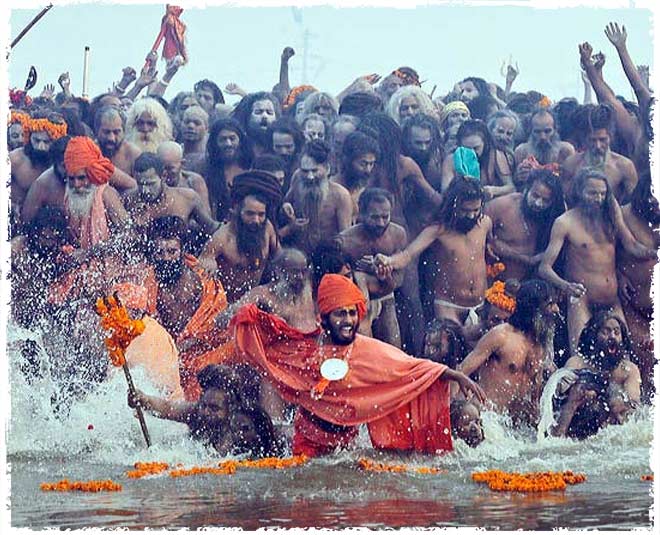Nagas at the Kumbh
images.herzindagi.info
Flamboyant pictures of Naga Babas and ascetics in various expressions of Sanatana Dharma have descended upon the holy city of Varanasi and Allahabad. Some of them beat our imagination on displaying their attention grabbing attires with dashes of Vermillion smeared on their foreheads. Yes, I roughly knew the importance of the Mahakumbh but this vibrance brought me to dig further, Nagas they are but who are these people really?
Ash clad, fearless, aggressive and unstoppable, these people draw their identity from the ancient ascetics group established by the great sage Adi Shankara. They belong to the Dashanami Sampradaya, the armed order of warrior ascetics, the Astradharis, who have come to sport a trishul that marks their individual identity and its presence describes them as the protectors of the Hindu ecosystem from calamity.
They have a past, one ridden with massacre and bloodshed, they didn't kill but they were killed in thousands by the then tyrannical emperor Aurangzeb but he couldn’t wipe out their existence entirely. That's the wonder about Hinduism, it has survived every onslaught of insult and destruction till date… including the unnecessary, apparently liberal, peevish noise in social media these days, that adds to the din of normal existence..
Akharas today play a major part at the Kumbh, their presence is honourable as they have been the keepers of the faith, through history. But their importance in their world is defined by the politics that governs the various akharas that dot our countryside, not as much as the Hindu army that was designed to protect the intellects - the Shastradharis, or the protectors of Hinduism as envisioned by the great Seer, Adi Shankara.
Kumbh Mela 2019 Kinnar Akhada (News 18)
The Mahamandaleshwars are chosen by their peers and they come to head the respective akharas. While women still don’t have a presence here, the transgenders have taken centre stage in this Kumbh Mela. Spiritual discussions, Satsangs and solving organizational discord are the topics of discussion in these great meetings of saints. All in all its a great spectacle of spiritual brilliance and a unique flavour to imbibe if we want to explore a new world… but does it solve a deeper quest of spiritualism… am not quite sure, beyond reverence for these saintly men, they don’t quite affect our lives and ideologies anymore, except being a brilliant spectacle at the Mahakumbh.
Naga babas are a mysterious bunch, who perform austerities in the silence of the Himalayas and descend into civilisation when the Mahakumbh calls them. There is a huge divide between them (the keepers of the faith) and us (the followers of some definition of the same faith). There must have been a time when they affected the ecosystem of the common people. In today’s world the enemy somehow doesn’t appear half as much as how Adi Shankara had envisioned it. The enemy is deep within society modernizing itself and questioning metaphysical aspects of spiritualism by the apparatus of western logic, on what purpose the Hindu way of life serves.
Do these Akharas have the answer to a far more complex and pertinent question on the way of life that promises the vision of God in some form, tangible to human capability? While the life they lead as a recluse bunch does deserve a lot of credit, there is a very thick invisible wall that separates them from us. We are confused for sure, but gone are the days of being a witness to a discussion, one like that between Mandana Mishra and Adi Shankara… somewhere in our rat race and in the din of the virtual world… are we forgetting the true potential of the spiritual world and our individual capability to get there?
The Mahakumbh was to take us in that direction promising us salvation by a sacred dip at the auspicious hour in the Ganges, we have in today’s world reduced it to an extravagant spiritual spectacle. While there are still a few gems in that crowd who are unapproachable and probably are at the doorstep of Nirvana, the current crop doesn’t come with the vibrant charm that once walked the earth by the name - Adi Shankaracharya.
Truly such spiritual brilliance is hard to come by in today’s times.


















